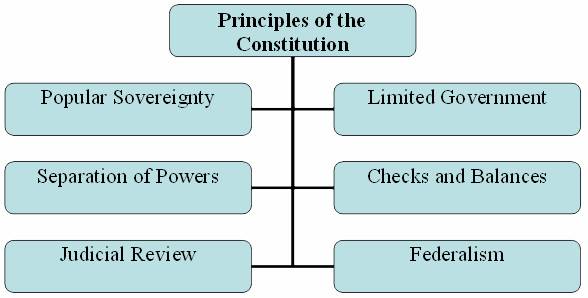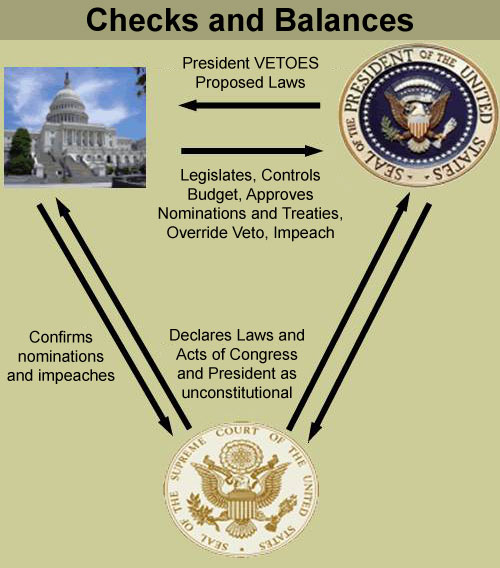|
Government : Constitutional Principles : Section Two
Principles of the Constitution
The six major principles of the Constitution are popular sovereignty, separation of powers, judicial review, limited government, checks and balances and federalism. Let’s examine each of these carefully.

Popular Sovereignty:
Popular sovereignty means rule by the people. This is a principle that came from the ideas of philosophers such as John Locke, Thomas Hobbes and Jean-Jacque Rousseau, and dates back to the mid 1600s.
The idea of popular sovereignty is the basis of democracy in general. The word democracy is Greek for “the people rule.” It goes along with the belief in the consent of the governed – that the people must agree to be governed in order for a government to be legitimate.
The ideas of popular sovereignty are clear in the opening phrase of the Preamble to the Constitution where it says “We the People.” The framers made it clear that the power of the government comes from the people themselves. This was a rather radical idea in the 18th century, and some of the framers were afraid to give too much power to the people, so they found it necessary to find a balance in creating the new government. As we discussed in Unit 1, the United States is a representative, or indirect, democracy because it is far too large to have a direct democracy in which all citizens are directly involved in government. We elect officials to represent our interests in our government.
Limited Government:
The idea of limited government was a very important principle for the framers. Limited government means that the national government does not have absolute authority. After just coming out of a tyrannical British rule, the framers wanted to be sure the national government did not have too much power. They established a system in which the government must obey the law and conduct business according to the Constitution. The principle of limited government is also known as the rule of law. No one in the government is above the law.
The Bill of Rights is one part of the Constitution that limits the powers of the government. It establishes certain freedoms such as that of free speech and press, and prevents the government from establishing or supporting a state religion.
Separation of Powers and Checks and Balances:
Separation of powers is the term for the fact that the government is divided into three different branches, each with its own job:
Legislative – makes laws
Executive – makes sure laws are followed
Judicial – interprets the laws
It is best to examine separation of powers along with checks and balances because the two concepts go together. Separation of powers gives each branch a task, but checks and balances allow the different branches some oversight into what the other branches are doing. This power prevents the branches from abusing their power because there is always someone “looking over their shoulder.” We use the term “check” to refer to each branch’s ability to monitor the activity of the other branches. The term “balance” is used to refer to the ability of each branch to limit the power of the others.
The system of checks and balances can be drawn in a triangle diagram with arrows between the branches showing how they check one another. Below is an example of such a diagram. It shows a couple of examples of how the branches check each other.

One example of checks and balances can be seen in the process of how a bill becomes a law. If Congress passes a bill, it goes the president for approval. If the president disagrees, he or she can veto, or reject, this law. Then the bill goes back to Congress. Congress can override the veto with a 2/3 majority vote in both Houses. This gives the legislative and executive branches a chance to balance one another.
 Judicial Review: Judicial Review:
The judicial branch is entrusted with the power of judicial review. This is the court system’s ability to check the legislative branch and executive branch to make sure specific laws and executive actions do not violate the Constitution.
One interesting fact is that judicial review is not specifically mentioned in the Constitution. The Supreme Court case of Marbury v. Madison (1803) established this principle when the Court struck down an act of Congress as being unconstitutional. This power allows the court to act as a watchdog over the other branches of government.
Throughout American history, fewer than 200 federal laws have been declared unconstitutional; however, the court has also acted in cases involving state and local laws. We will investigate this in more depth in Unit 6.
Federalism:
As previously defined, federalism is the separation of powers between various levels of government. Certain powers belong exclusively to the national government, some are exclusive to the states' governments, and others are shared. This system was created in the United States as a means of compromise when the Articles of Confederation did not work. A strong central government, like that under British rule, was not desirable to the Founders, however a weak central government, like that under the Articles, proved to not work either. Federalism divided the powers so that the central government was neither too strong nor too weak. This important concept will be covered in detail in the next section.
 Watch this video on the principles of the Constitution. Watch this video on the principles of the Constitution.
 Before completing the section quiz, let’s play a game to practice your knowledge of the content of this section. Before completing the section quiz, let’s play a game to practice your knowledge of the content of this section.
 Now it’s time to complete the Section 2 quiz. Now it’s time to complete the Section 2 quiz.
Go to next section |